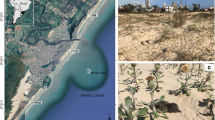Summary
The study population of the Aquatic Warbler showed a low proportion of unfertile eggs (8.6 %), very low nest losses (17.9 %), including losses from predation (11.1 %), and high average production of fledglings per nest (3.25 ±1.9) compared with populations of its congeners and other related species. As adult mortality also seems low, it is concluded that the main threat to this endangered species in the study area may be change of habitat.
Zusammenfassung
Eine Population des Seggenrohrsängers in Polen wies im Vergleich zu Gattungsverwandten und anderen nahe verwandten Arten geringe bis sehr geringe Anteile an unbefruchteten Eiern (8,6 %) und Nestverlusten (17,9 %; einschließlich 11,1 % Verluste durch Nesträuber) sowie hohe Jungenproduktion pro Nest (3,25 ±1,9) auf. Da auch die Adultmortalität ziemliche niedrig zu sein scheint, ist zu schließen, daß eine Gefährdung der seltenen Art im Untersuchungsgebiet hauptsächlich von einer Habitatänderung ausgeht.
Similar content being viewed by others
Literature
Bibby, C. J. (1978): Some breeding statistics of Reed and Sedge Warbler. Bird Study 25: 206–222.
Dowsett-Lemaire, F. (1981): Eco-ethological aspects of breeding in the Marsh Warbler. Rev. Ecol. 35: 437–491.
Dyrcz, A. (1981): Breeding ecology of Great Reed Warbler and Reed Warbler at fish ponds in SW Poland and lakes in NW Switzerland. Acta orn. 18: 307–333.
Ditto (1986): Factors affecting facultative polygyny and breeding results in the Great Reed Warbler (Acrocephalus arundinaceus). J. Orn. 127: 447–461.
Ditto (1989): Polygyny in the Aquatic WarblerAcrocephalus paludicola. Ibis 131: 298–300.
Ditto (1993): On the nesting biology of the Aquatic WarblerAcrocephalus paludicola on the Biebrza marshes (NE Poland). Vogelwelt 114: 2–15.
Ditto &W. Zdunek (in press): Breeding ecology of the Aquatic WarblerAcrocephalus paludicola on the Biebrza marshes, northeast Poland. Ibis.
Heise, G. (1970): Zur Brutbiologie des Seggenrohrsängers (Acrocephalus paludicola). J. Orn. 111: 54–67.
Koskimies, P. (1991):Acrocephalus schoenobaenus (Linnaeus 1758) — Schilfrohrsanger. In:Glutz v.Blotzheim, U. N., &K. M. Bauer, Handbuch der Vögel Mitteleuropas 12/I: 291–340. Wiesbaden.
Leisler, B. (1981): Die ökologische Einnischung der mitteleuropäischen Rohrsänger (Acrocephalus, Sylviinae). I. Habitattrennung. Vogelwarte 31: 45–74.
Ditto (1991):Acrocephalus melanopogon (Temminck 1823) — Mariskensänger.Acrocephalus arundinaceus (Linnaeus 1758) — Drosselrohrsänger. In:Glutz v.Blotzheim, U. N., &K. M. Bauer, Handbuch der Vögel Mitteleuropas 12/I: 217–252, 486–539. Wiesbaden.
Ditto &C. Catchpole (1992): The evolution of polygamy in European reed warblers of the genusAcrocephalus: a comparative approach. Ethology, Ecology and Evolution 4: 225–243.
Mackowicz, R. (1989): Breeding biology of the river Warbler in northeastern Poland. Acta zool. cracov. 32: 331–437.
Mayfield, H. (1975): Suggestions for calculating nest success. Wilson Bull. 87: 456–466.
Nice, M. M. (1957): Nesting success in altricial birds. Auk 74: 305–321.
Pikulski, A. (1986): Breeding biology and ecology of Savi's WarblerLocustella luscinioides at Milicz fishponds. Ptaki. Slaska 4: 2–39.
Ricklefs, R. E. (1969): An analysis of nesting mortality in birds. Smithson. Contrib. Zool. 9: 1–48.
Schulze-Hagen, K. (1983): Der Bruterfolg beim Sumpfrohrsänger. Charadrius 19: 36–45.
Ditto (1991):Acrocephalus palustris (Bechstein 1798) — Sumpfrohrsanger.Acrocephalus scirpaceus (Hermann, 1804) — Teichrohrsanger. In:Glutz v.Blotzheim, U.N., &K. M. Bauer, Handbuch der Vögel Mitteleuropas 12/I, 377–486. Wiesbaden.
Ditto,H. Flinks &A. Dyrcz (1989): Brutzeitliche Beutewahl beim SeggenrohrsängerAcrocephalus paludicola. J. Orn. 130: 251–255.
DittoH. Flinks &W. Mädlow (1986): Brutstatistik des Sumpfrohsängers bei wirtschaftlicher Nutzung des Habitats. Orn. Ber. Berlin 11: 19–26.
Voous, K. H. (1960): Atlas of European Birds. Amsterdam.
Wawrzyniak, H., &G. Sohns (1974): Über Gelegegrosse, Nestlingszeit, Brutfolge und Verluste beim Seggenrohrsänger,Acrocephalus paludicola (Vieillot). Beitr. Vogelkde. 20: 105–113.
Ditto (1977): Der Seggenrohrsänger. Wittenberg Lutherstadt.
Author information
Authors and Affiliations
Rights and permissions
About this article
Cite this article
Dyrcz, A., Zdunek, W. Breeding statistics of the Aquatic WarblerAcrocephalus paludicola on the Biebrza marshes, northeast Poland. J Ornithol 134, 317–323 (1993). https://doi.org/10.1007/BF01640427
Published:
Issue Date:
DOI: https://doi.org/10.1007/BF01640427



